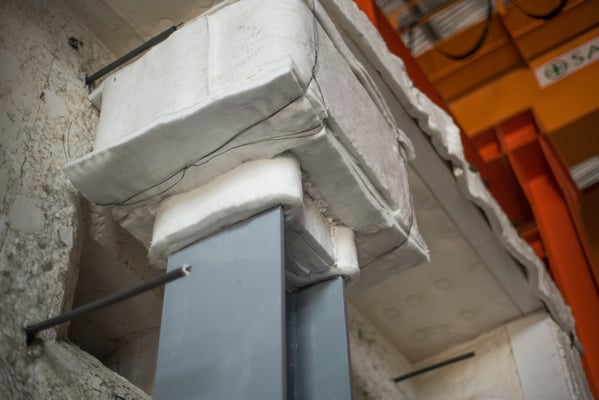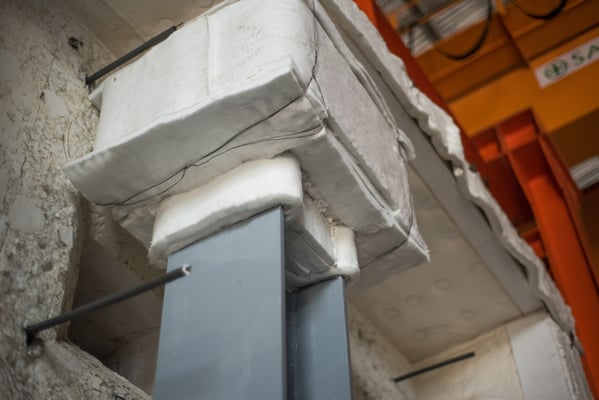Fireproofing refers to making something fire resistant or non-combustible. It can be an entire structure, a specific material or some building components. This is considered a passive fire protection measure.
There are several fire protection methods used in construction. However, it is important to emphasize that items classified as “fireproof” are resistant to a specific circumstance. In other words, the item may be damaged by a fire that exceeds the intensity or duration for which it was designed.
Get a reliable fire protection design and protect your building and its occupants.
Waterproofing in Steel Structure Construction
Structural steel melts at approximately 2,500°F, while building fires typically reach a temperature in the 2,000°F range. The possibility of steel melting is rare, but this does not mean that steel structures are safe. Consider that the material deforms and loses strength when exposed to high temperatures. Building codes require fireproof protection for structural steel as a safety precaution.
Fireproof steel will ensure that a building maintains its shape in the event of a fire, allowing people to escape in an emergency. Commercial structural steel must meet at least a 2-hour fire resistance rating, among other requirements. Common ratings are 2, 3, and 4 hour marks. AISC certified structural steel manufacturers are qualified to meet your fire protection needs.
Method for fire protection of structural steel
The most common form of fire protection is by spraying low-density fibers or cementitious compounds, called spray-applied fire-resistant materials or SFRM. These sprays can be applied wet or dry, in coatings of the desired thickness, to provide heat resistance to the steel. However, they are also used in wood, fabrics, and other materials. Although sprays are the most common, they are not the only option, and this section will describe other options.
Intumescent Coatings
These coatings are also known as intumescent paints and provide fire resistance to steel members. Intumescent coatings can expand up to 100 times their original thickness, providing greater resistance by creating a buffer between a steel element and the fire. The coatings will undergo a chemical reaction and expand when exposed to extreme heat. This product is applied as paint and commonly used on steel exposed to the general public.

Flexible blanket systems
Flexible blankets are designed for specific needs and can be used as a fireproof material. The method is very practical, but there are a limited number of manufacturers. This method meets almost all security standards and codes. Provides a reliable barrier to prevent fire from spreading to structural members while maintaining a toxic-free environment.
Fireproof Rigid Board
Rigid plate fire protection is available in different thicknesses and can be easily installed during the steel deck and beam installation process. These boards are moisture resistant and provide fire protection, thermal insulation and acoustic control, preventing pest attacks.
Concrete
Concrete is nowadays less popular as a fireproof material for steel and is mainly used to clad large sections of steel. This requires more space than other options, due to the volume of concrete used. Additionally, it is not as aesthetically pleasing as other options, so it is used in places where appearance is not the main concern.
Fire protection of steel elements on site: dangers and disadvantages
Fireproof steel elements on the construction site should be avoided at all costs. This will delay production and can also be a health hazard to employees, especially with fireproof paints or sprayed fire-resistant materials.
Fireproof coatings
To activate the paint, the chemical mixture is exposed to extreme heat, which releases toxic fumes. This method does not require column coverage, which makes it more attractive than spraying, but the vapors can be dangerous to the user and nearby workers.
Fireproof spray
SFRM includes ingredients such as gypsum, carbon black and cement. These materials are usually mixed with highly reactive chemicals to speed up the hardening process. These chemicals are very dangerous for people and can cause sinus infections, lung cancer, and other respiratory problems.
Project delays
On-site fire protection will create construction delays regardless of whether the work is carried out by a fire protection specialist or the construction team.
- Employees will have to maneuver around the workplace.
- Areas will need to be blocked off to prevent anyone from bumping into wet foam or paint, and materials will need to be completely dry before final installation.
Another disadvantage is the additional supervision required to ensure adequate fire protection, which is not necessary when elements are manufactured offsite by certified manufacturers.
Conclusion
In a fire outbreak, structural steel fire protection can make the difference between the entire building structure suffering damage and a total collapse. Passive fire protection acts as a complement to active measures such as fire sprinklers, making buildings safer for occupants while protecting the owner's investment.

